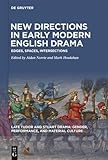New Directions in Early Modern English Drama : Edges, Spaces, Intersections / ed. by Aidan Norrie, Mark Houlahan.
Material type: TextSeries: Late Tudor and Stuart Drama : Gender, Performance, and Material CulturePublisher: Kalamazoo, MI : Medieval Institute Publications, [2020]Copyright date: ©2020Description: 1 online resource (XVIII, 265 p.)Content type:
TextSeries: Late Tudor and Stuart Drama : Gender, Performance, and Material CulturePublisher: Kalamazoo, MI : Medieval Institute Publications, [2020]Copyright date: ©2020Description: 1 online resource (XVIII, 265 p.)Content type: - 9781501518218
- 9781501514029
- 9781501513749
- 822/.309 23
- PR651 .N48 2020
- PR651
- online - DeGruyter
- Issued also in print.
| Item type | Current library | Call number | URL | Status | Notes | Barcode | |
|---|---|---|---|---|---|---|---|
 eBook
eBook
|
Biblioteca "Angelicum" Pont. Univ. S.Tommaso d'Aquino Nuvola online | online - DeGruyter (Browse shelf(Opens below)) | Online access | Not for loan (Accesso limitato) | Accesso per gli utenti autorizzati / Access for authorized users | (dgr)9781501513749 |
Frontmatter -- Contents -- List of Figures -- Acknowledgments -- Foreword: The Stage on the Shore -- Chapter 1. Introduction: Edges, Spaces, and Intersections in Early Modern English Drama -- Section I: Edges -- Chapter 2. A Life on the Edge: Richard Bradshaw -- Chapter 3. “Thou Dream’st Awake”: Ghosts and Sleep in Chapman’s Antonio’s Revenge and Marston’s Bussy D’Ambois -- Chapter 4. Canting Queer Ken: Stage Magic and the Edge of Knowledge -- Chapter 5. James Shirley at the Edge of Town -- Section II: Spaces -- Chapter 6. “Our Queen Is Comming to the Town”: Child Actors and Counsel in the Elizabethan Progresses of 1574 and 1578 -- Chapter 7. “And Huh, Too / For All Your Big Words!”: Language and Multiculturalism in Philip Massinger’s The Renegado -- Chapter 8. Inherited Insecurities and the Staging of Alterity: Islam in Marlowe’s Tamburlaine -- Chapter 9. “The End of All”: How a Forgotten Map Helped Us Forget Newington Butts -- Section III: Intersections -- Chapter 10. Hamlet’s French Philosophy -- Chapter 11. “Then Turn Tail to Tail and Peace Be with You”: John Fletcher’s The Woman’s Prize, or The Tamer Tamed, Menippean Satire, and Same-Sex Desire -- Chapter 12. “Whose Plot Was This?”: Shakespearean Convergences in Fletcher’s The Wild-Goose Chase -- Chapter 13. “They Always Speak Things as They Would Have Them”: Aspirational Royalist Politics in Henry Killigrew’s Pallantus and Eudora (1653 -- Notes on Contributors -- Index of Persons, Places, and Subjects
restricted access online access with authorization star
http://purl.org/coar/access_right/c_16ec
This collection examines some of the people, places, and plays at the edge of early modern English drama. Recent scholarship has begun to think more critically about the edge, particularly in relation to the canon and canonicity. This book demonstrates that the people and concepts long seen as on the edge of early modern English drama made vital contributions both within the fictive worlds of early modern plays, and without, in the real worlds of playmakers, theaters, and audiences. The book engages with topics such as child actors, alterity, sexuality, foreignness, and locality to acknowledge and extend the rich sense of playmaking and all its ancillary activities that have emerged over the last decade. The essays by a global team of scholars bring to life people and practices that flourished on the edge, manifesting their importance to both early modern audiences, and to current readers and performers.
Issued also in print.
Mode of access: Internet via World Wide Web.
In English.
Description based on online resource; title from PDF title page (publisher's Web site, viewed 25. Jun 2024)


